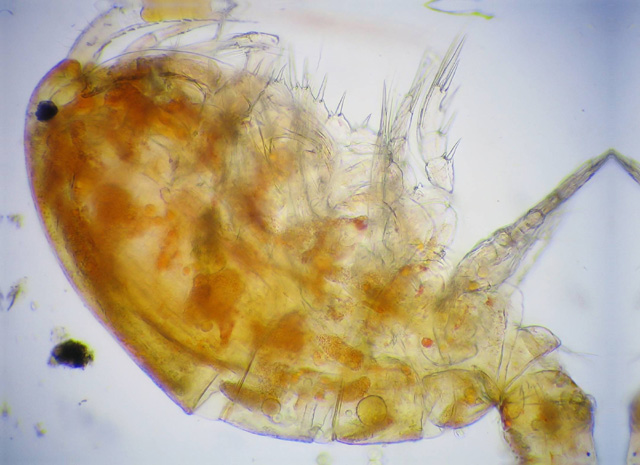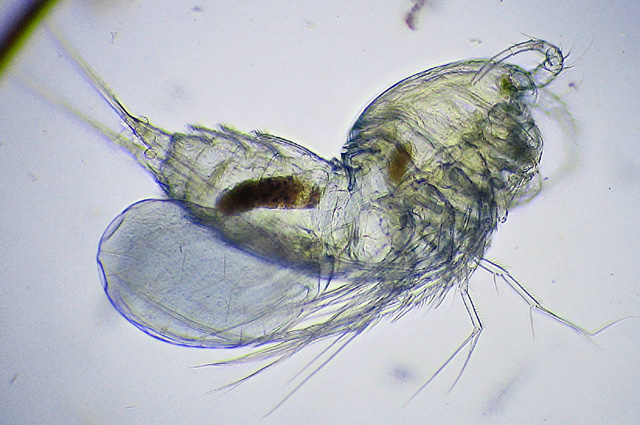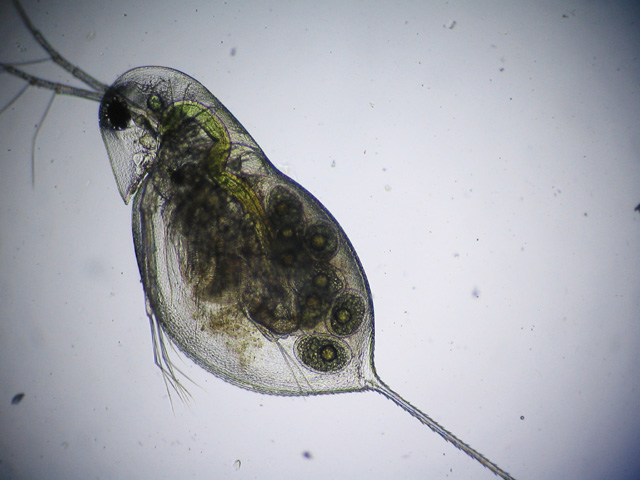
|
A Pond in Winter by Howard Webb (St. Louis, MO, USA) |
Robert Pavlis had a good article last month on creating an LED light for his Wild M40. I lack his machining skills, but on the other hand, my microscope doesn't have the tight tolerances Robert had to work with. My original light was a 15 watt 120 volt incandescent bulb, in a 2 inch by 2 inch by 3 inch box (a picture of it was in a previous article). A groove in the side of the box slides into the holder. Thus I have plenty of space for bulbs, batteries and anything else.
I had previously tried using an LED, and an LED flashlight with my microscope, but the mechanics of holding the parts in place were more of a nuisance than I wanted to address. Robert's article, however challenged me to give it another try. A couple of months ago, I 'upgraded' several of my MiniMag flashlights to using a LED replacement bulb. The replacement bulb is manufactured by Nite-Ize, and available at a major discount store for about $5 US. It struck me that this might be a good alternative, as the electronics for working with 2 AA batteries were already incorporated into this bulb housing. The only issue I had to address was building a holder for the bulb, and wiring up the batteries.
|
|
| Nite Ize LED replacement bulb |
For a working prototype, I cut a 2x3 inch piece of scrap wood, and routed a groove in the sides to fit the existing holder. I then drilled a shallow 5/8 inch hole in a position approximately where the bulb of the original light was located (to align with the condenser and light path). To keep the light from scattering everywhere, I cut a 3/4 inch ring of PVC pipe, and hot glued it to the board. The light needed a diffuser, so I took a scrap of plastic, cut to fit the top of the PVC, and lightly sanded it to diffuse the light. The biggest challenge was attaching the wires to the bulb, without permanently soldering the wire to the leads. This turned out to be much simpler than I expected, as I simply heated the plastic coating on the wire, and shoved the wire over the leads on the bulb (mashing the lead into the midst of the wire strands). It is very crude, but works great. I will likely clean up the construction a bit, and add an on/off switch (easier than removing batteries), but see no need to make any other modifications.

|
| Prototype Light Assembly |
The light is almost too bright for visual observation, but a neutral density grey filter cuts it down to an appropriate level. I was amazed at the color of the images the new light produced. I think this is a major improvement, and will likely not go back to my original light.
While taking pictures for this article, I again was getting frustrated with the limited depth of field of my optics. I remembered some articles a while back on a software program called CombineZ by Alan Hadley. I went out to his web site and downloaded the latest version. CombineZ takes what is called a "Z stack" of images (essentially layered slices of a subject) and combines them into a single image. There are a number of macro options, but it essentially takes the best focused parts of each image and combines them into one. All I can say is it does what it claims and works great. I will let the images speak for themselves.
I will finally get to my original subject. In early February of this year, I again went up to Dormition Monastery in Michigan (see previous article). It has been a a relatively mild winter, and the pond was clear of ice when we first arrived, though a cold-front soon moved in, freezing the surface and cutting off access for further sampling. I managed to get three bottles of specimens.
I had hoped to catch some Daphnia rosae, but there was not one single specimen in any of the collections. Quite a change from the clouds of them last spring. Not unexpectedly, there were a good number of cyclops (copepods), and surprisingly, still a good population of V olvox.
The lack of daphnia, while disappointing, was not totally unexpected. After laying a large number of dormant resting eggs in the summer and fall, populations normally drop off or disappear during the winter. A number of these eggs were evident in my collection bottles, and I deliberately scooped up about 1/2 cup of mud in hope that I could hatch some out when I got home. Sure enough, within four days of getting home, and placing the bottles in a warm environment, I had an established a growing population of Daphnia rosae.
Compare these images, to the ones in my previous monastery article (the subjects are similar), to see the difference that the LED makes, and how CombineZ gives the effect of a good depth of field.
Resting Egg
|
|
|
First image of resting daphnia egg |
|
|
| Second image of resting egg. |
|
Combined image of dormant egg (click for full size) |
Copepod
|
Pair of Copepods (note focus on mandibles) |
Other Cladocera
|
|
|
Note focus on legs,
but not on head |

|
| Copepod - three images using CombineZ |

|
| Copepod - two images using ComibineZ |
|
|
|
Copepod larvae
and Volvox |
|
Bosminia |
Daphnia rosae

|
| Daphnia rosae
(single image) 40x bright field |

|
| Daphnia
rosae 100x bright field |

|
| Daphnia rosae - three images CombineZ |
Water
temperature: 2 degrees Centigrade
Depth: collected near the shore, at
less than a meter
Secci visibility: moderate
Location: lat: 42.26767, long: -84.49290
Microscope: Bausch & Lomb monocular, 10x ocular, 4x, 10x and 40x objectives.
Camera: Canon A70
Software: Cannon Remote Capture, Photoshop Elements, CombineZ5
Comments to the author Howard Webb are welcomed.
Published in the March 2006 edition of Micscape Magazine.
Please report any
Web problems or offer general comments to the
Micscape Editor,
via the contact on current Micscape
Index.
Micscape is the
on-line monthly magazine of the Microscopy UK web
site at
http://www.microscopy-uk.org.uk/